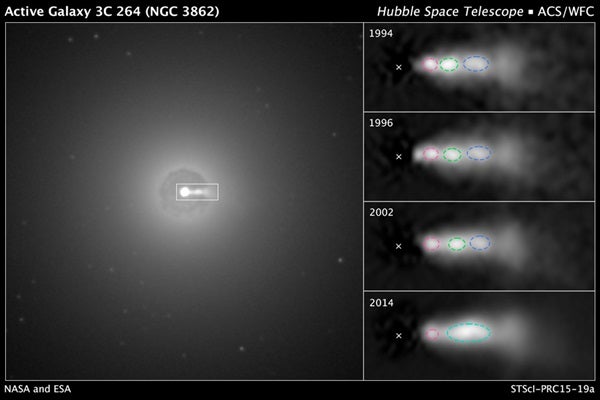[Right] A sequence of Hubble images of knots (outlined in red, green, and blue) shows them moving along the jet over a 20-year span of observing. Astronomers were surprised to discover that the central knot (green) caught up with and merged with the knot in front of it (blue). The new analysis suggests that shocks produced by collisions within the jet further accelerate particles that are confined to a narrowly focused beam of radiation. The “X” marks the location of the black hole.
The finding offers new insights into the behavior of “light-saber-like” jets that are so energized that they appear to zoom out of black holes at speeds several times the speed of light. This “superluminal” motion is an optical illusion due to the fast real speed of the plasma, which is close to the universal maximum of the speed of light.
Such extragalactic jets are not well understood. They appear to transport energetic plasma in a confined beam from the active nucleus of the host galaxy. The new analysis suggests that shocks produced by collisions within the jet further accelerate particles and brighten the regions of colliding material.
The video of the jet was assembled with two decades’ worth of NASA Hubble Space Telescope images of the elliptical galaxy NGC 3862, the sixth-brightest galaxy and one of only a few active galaxies with jets seen in visible light. In 1992, Hubble discovered the jet in optical light. NGC 3862 is in a rich cluster of galaxies known as Abell 1367 in the constellation Leo.
The jet from NGC 3862 has a string-of-pearls structure of glowing knots of material. Taking advantage of Hubble’s sharp resolution and long-term optical stability, Eileen Meyer of the Space Telescope Science Institute (STScI) in Baltimore, Maryland, matched archival Hubble images with a new deep image taken in 2014 to better understand jet motions. Meyer was surprised to see a fast knot with an apparent speed of seven times the speed of light catch up with the end of a slower moving, but still superluminal, knot along the string.
The resulting “shock collision” caused the merging blobs to brighten significantly.
“Something like this has never been seen before in an extragalactic jet,” said Meyer. As the knots continue merging, they will brighten further in the coming decades. “This will allow us a very rare opportunity to see how the kinetic energy of the collision is dissipated into radiation.”
Whatever the mechanism, the fast-moving knot will burrow its way out into intergalactic space. A knot launched later, behind the first one, may have less drag from the shoveled-out interstellar medium and catch up to the earlier knot, rear-ending it in a shock collision.
Beyond the collision, which will play out over the next few decades, this discovery marks only the second case of superluminal motion measured at hundreds to thousands of light-years from the black hole where the jet was launched. This indicates that the jets are still close to the speed of light even on distances that start to rival the scale of the host galaxy. These measurements can give insights into how much energy jets carry out into their host galaxy and beyond, which is important for understanding how galaxies evolve as the universe ages.
Meyer is currently making a Hubble-image video of two more jets in the nearby universe to look for similar fast motions. She notes that these kinds of studies are only possible because of the long operating lifetime of Hubble, which has now been looking at some of these jets for over 20 years.
Extragalactic jets have been detected at X-ray and radio wavelengths in many active galaxies powered by central black holes, but only a few have been seen in optical light. Astronomers do not yet understand why some jets are seen in visible light and others are not.











